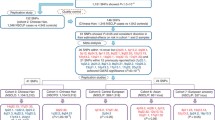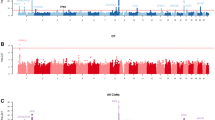Abstract
Isolated oral clefts, including cleft lip with/without cleft palate (CL/P) and cleft palate (CP), have a complex and heterogeneous etiology. Case-parent trios from three populations were used to study genes spanning chromosome 2, where single nucleotide polymorphic (SNP) markers were analyzed individually and as haplotypes. Case-parent trios from three populations (74 from Maryland, 64 from Singapore and 95 from Taiwan) were genotyped for 962 SNPs in 104 genes on chromosome 2, including two well-recognized candidate genes: TGFA and SATB2. Individual SNPs and haplotypes (in sliding windows of 2–5 SNPs) were used to test for linkage and disequilibrium separately in CL/P and CP trios. A novel candidate gene (ZNF533) showed consistent evidence of linkage and disequilibrium in all three populations for both CL/P and CP. SNPs in key regions of ZNF533 showed considerable variability in estimated genotypic odds ratios and their significance, suggesting allelic heterogeneity. Haplotype frequencies for regions of ZNF533 were estimated and used to partition genetic variance into among-and within-population components. Wright’s fixation index, a measure of genetic diversity, showed little difference between Singapore and Taiwan compared with Maryland. The tensin-1 gene (TNS1) also showed evidence of linkage and disequilibrium among both CL/P and CP trios in all three populations, albeit at a lower level of significance. Additional genes (VAX2, GLI2, ZHFX1B on 2p; WNT6–WNT10A and COL4A3–COL4A4 on 2q) showed consistent evidence of linkage and disequilibrium only among CL/P trios in all three populations, and TGFA showed significant evidence in two of three populations.







Similar content being viewed by others
References
Ardinger HH, Beutow KH, Bell GI, Bardach J, VanDemark DR, Murray JC (1989) Association of genetic variation of the transforming growth factor alpha gene with cleft lip and palate. Am J Hum Genet 45:348–353
Barbieri AM, Lupo G, Bulfone A, Andreazzoli M, Mariani M, Fougerousse F, Consalez GG, Borsani G, Beckmann JS, Barsacchi G, Ballabio A, Banfi S (1999) A homeobox gene, vax2, controls the patterning of the eye dorsoventral axis. PNAS 96:10729–10734
Beaty TH, Wang H, Hetmanski JB, Fan YT, Zeiger JS, Liang KY, Chiu YF, Vanderkolk CA, Seifert KC, Wulfsberg EA, Raymond G, Panny SR, McIntosh I (2001) A case-control study of nonsyndromic oral clefts in Maryland. Ann Epidem 11:434–442
Beaty TH, Hetmanski JB, Zeiger JS, Fan YT, Liang KY, VanderKolk CA, McIntosh I (2002) Testing candidate genes for oral clefts using the case-parent trio design. GENET EPI 22:1–11
Bellus GA, Hefferon TW, Luna RIO, Hecht JT, Horton WA, Machado M, Kaitila I, McIntosh I, Francomano CA (1995) Achondroplasia is defined by recurrent G380R mutations of FGFR3. Am J Hum Genet 56:368–373
Blanco R, Suazo J, Santos JL, Paredes M, Sung H, Carreno H, Jara L (2004) Association between 10 microsatellite markers and nonsyndromic cleft lip palate in the Chilean population. Cleft Palate-Craniofac J 41:163–167
Butkowski RJ, Wieslander J, Kleppel M, Michael AF, Fish AJ (1989) Basement membrane collagen in the kidney: regional localization of novel chains related to collagen IV. Kidney Int 35:1195–1202
Chen H, Duncan IC, Bozorgchami H, Lo SH (2002) Tensin1 and a previously undocumented family member, tensin2, positively regulate cell migration. Proc Nat Acad Sci 99:733–738
Collins AL, Lunt PW, Garrett C, Dennis NR. (1993) Holoprosencephaly: a family showing dominant inheritance and variable expression. J Med Genet 30:36–40
Cooper ME, Ratay J, Marazita ML (2006) Asian oral-facial cleft birth prevalence. Cleft-Palate Craniofac J (e-pub)
Excoffier L (2003) Analysis of population subdivision. In: Balding DJ, Bishop M, Cannings C (eds) Handbook of statistical genetics, 2nd edn. Wiley, West Sussex, England, pp 713–745
Fan JB, Oliphant A, Shen R, Kermani BG, Garcia F, Gunderson KL, Hansen M, Steemers F, Butler SL, Deloukas P, Galver L, Hunt S, McBride C, Bibikova M, Rubano T, Chen J, Wickham E, Doucet D, Chang W, Campbell D, Zhang B, Kruglyak S, Bentley D, Haas J, Rigault P, Zhou L, Steulpnagel J, Chee MS (2003) Highly parallel SNP genotyping. Cold Spring Harb Symp Quant Biol 68:69–78
Fitzpatrick DR, Carr IM, McLaren L, Leek JP, Wightman P, Williamson K, Gautier P, McGill N, Hayward C, Firth H, Markham AF, Fantes JA, Bonthron DT (2003) Identification of SATB2 as the cleft palate gene on 2q32-q33. Hum Mol Genet 12:2491–2501
Horvath S, Xu X, Laird NM (2001) The family based association test method: strategies for studying general genotype–phenotype associations. Eur J Hum Genet 9:301–306
Jezewski PA, Vieira AR, Nishimura C, Ludwig B, Johnson M, O’Brien SE et al (2003) Complete sequencing shows a role for MSX1 in non-syndromic cleft lip and palate. J Med Genet 40:399–407
Jugessur A, Lie RT, Wilcox AJ, Murray JC, Taylor JA, Saugstad OD, Vindenes HA, Abyholm F (2003a) Variants of developmental genes (TGFA, TGFB3, and MSX1) and their associations with orofacial clefts: a case-parent triad analysis. Genet Epidem 24:230–239
Jugessur A, Lie RT, Wilcox AJ, Murray JC, Taylor JA, Saugstad OD, Vindenes HA, Abyholm FE. (2003b) Cleft palate, transforming growth factor alpha gene variants, and maternal exposures: assessing gene–environment interactions in case-parent triads. Genet Epidem 25:367–374
Laird NM, Horvath S, Xu X (2000) Implementing a unified approach to family-based tests of association. Genet Epidem 19(Suppl 1):S36–S42
Lidral AC, Murray JC. (2004) Genetic approaches to identify disease genes for birth defects with cleft lip/palate as a model. Birth Defects Res (Part A) 70:893–901
Little J, Cardy A, Munger RG. Tobacco smoking, oral clefts: a meta-analysis (2004) Bull World Health Organ 82:213–218
Maestri NE, Beaty TH, Hetmanski J, Smith EA, McIntosh I, Wyszynski DF, Liang K-Y, Duffy DL, VanderKolk C (1997) Application of transmission disequilibrium tests to nonsyndromic oral clefts: including candidate genes and environmental exposures in the models. Am J Med Genet 73:337–344
Mansilla MA, Cooper ME, Goldstein T, Castilla EE, Lopez Camelo JS, Marazita ML, Murray JC. (2006) Contributions of PTCH gene variants to isolated cleft lip and palate. Cleft Palate Craniofac J 43:21–29
Marazita ML, Field LL, Cooper ME, Tobias R, Maher BS, Peanchitlertkajorn S, Liu Y (2002) Genome scan for loci involved in cleft lip with or without cleft palate, in Chinese multiplex families. Am J Hum Genet 71:349–364
Marazita ML, Field LL, Tuncbilek G, Cooper ME, Goldstein T, Gursu KG (2004) Genome-scan for loci involved in cleft lip with or without cleft palate in consanguineous families from Turkey. Am J Med Genet 126A:111–122
Mitchell LE (1996) Transforming growth factor a locus and nonsyndromic cleft lip with or without cleft palate: A reappraisal. Genet Epidemiol 14:231–240
Mitchell LE. (2002) Twin studies in oral cleft research. In: Wyszynski DF (ed) Cleft lip and palate, Oxford University Press, Oxford, pp 214–221
Mossey PA, Little J (2002) Epidemiology of oral clefts: an international perspective. In: Wyszynksi DF (ed) Cleft lip and palate, Oxford University Press, Oxford, pp 127–158
Nyholt DR. (2004) A simple correction for multiple testing for single nucleotide polymorphisms in linkage disequilibrium with each other. Am J Hum Genet 74:765–769
Oliphant A, Barker DL, Stuelpnagel JR, Chee MS (2002) BeadArray™ technology: enabling an accurate, cost-efficient approach to high-throughput genotyping. Biotechniques 32:S56–S61
Prescott NJ, Lees MM, Winter RM, Malcolm S. (2000) Identification of susceptibility loci for nonsyndromic cleft lip with or without cleft palate in a two stage genome scan of affected sib-pairs. Hum Genet 106:345–350
Rabinowitz D, Laird N (2000) A unified approach to adjusting association tests for population admixture with arbitrary pedigree structure and arbitrary missing marker information. Hum Hered 50:211–223
Salyakina D, Seaman SR, Browning BL, Dudbridge F, Muller-Myhsok B. (2005) Evaluation of Nyholt’s procedure for multiple testing correction. Hum Hered 60:19–25
Strausberg RL, Feingold EA, Grouse LH, Derge JG, Klausner RD, Collins FS, Wagner L et al, Mammalian Gene Collection Program Team (2002) Generation and initial analysis of more than 15,000 full-length human and mouse cDNA sequences. Proc Natl Acad Sci USA 99:16899–16903
Vieira AR, Avila JR, Daack-Hirsch S, Dragan E, Félix TM, Rahimov F, Harrington J, Schultz RR, Watanabe Y, Johnson M, Fang J, O’Brien SE, Orioli IM, Castilla EE, FitzPatrick DR, Jiang R, Marazita ML, Murray JC (2005) Medical sequencing of candidate genes for nonsyndromic cleft lip and palate. Plos Genet 1:e64
Vieira AR (2006) Association between the transforming growth factor alpha gene and nonsyndromic oral clefts: A HuGE review. Am J Epidemiol 163:790-810
Wyszynski DF, Duffy DL, Beaty TH (1997) Maternal cigarette smoking and oral clefts: a meta-analysis. Cleft Palate-Craniofac J 34:206–210
Zeiger JS, Hetmanski JB, Beaty TH, VanderKolk CA, Wyszynski DF, Bailey-Wilson JE et al (2003) Evidence for linkage of non-syndromic cleft lip with or without cleft palate to a region on chromosome 2. Eur J Hum Genet 11:835–839
Zeiger JS, Beaty TH, Liang KY (2005) Oral clefts, maternal smoking and TGFA: meta-analysis of gene–environment interaction. Cleft Palate-Craniofac J 42:58–63
Zhang K, Sun F, Zhao H (2005) Haplore: a program for haplotype reconstruction in general pedigrees without recombination. Bioinformatics 21:90–103
Zucchero TM, Cooper ME, Maher BS, Daack-Hirsch S et al (2004) Interferon regulatory factor 6 (IRF6) gene variants and the risk of isolated cleft lip or palate. N Eng J Med 351:769–780
Zweier C, Albrecht B, Mitulla B, Behrens R, Beese M, Gillessen-Kaesbach G, Rott H.-D, Rauch A (2002) ‘Mowat-Wilson’ syndrome with and without Hirschsprung disease is a distinct, recognizable multiple congenital anomalies-mental retardation syndrome caused by mutations in the zinc finger homeo box 1B gene. Am J Med Genet 108: 177–181
Acknowledgments
This research was supported by R01-DE-10293, R21-DE-13707, R01-DE-13939 and R01-DE-14581 from the National Institute of Dental & Craniofacial Research. Information from the COGENE consortium was collected with support from N01-DE-92630. We thank all participants who donated samples from the Maryland oral cleft study, participants recruited from Chang Gung Memorial Hospital in Taipei, as well as those from KK Women’s & Children’s Hospital in Singapore. The hard work of staff at all three institutions is gratefully acknowledged and deeply appreciated. We are grateful to the Smile Train Foundation for supporting research on oral clefts in China, and we acknowledge support from D43-TW-06176 which fostered collaborations in China.
Author information
Authors and Affiliations
Corresponding author
Electronic supplementary material
Rights and permissions
About this article
Cite this article
Beaty, T.H., Hetmanski, J.B., Fallin, M.D. et al. Analysis of candidate genes on chromosome 2 in oral cleft case-parent trios from three populations. Hum Genet 120, 501–518 (2006). https://doi.org/10.1007/s00439-006-0235-9
Received:
Revised:
Accepted:
Published:
Issue Date:
DOI: https://doi.org/10.1007/s00439-006-0235-9




